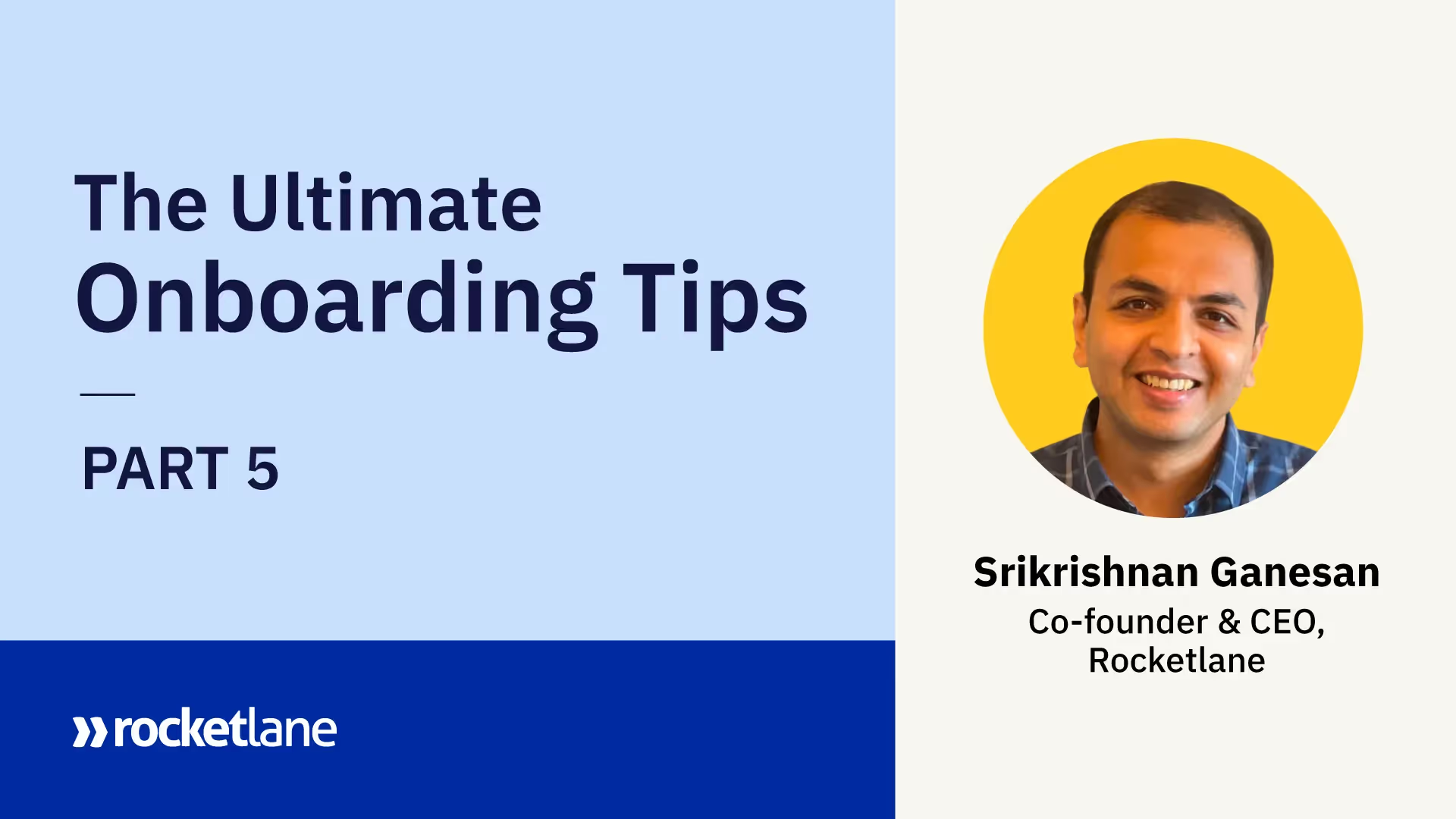Welcome to Part V of the Customer Onboarding Tips blog series. In part IV, we looked at the importance of continuous feedback, having the human touch in onboarding, and setting a cadence for communication amongst other things.
In this installment, we’ll understand the importance of training videos, readiness kits, engineering a great first impression, and more.
Grab a cup of coffee and put on your note-taking hat!
Tip #21: Training videos vs. live training
This tip concerns the suitability of training videos vs. live training and other options to consider during your onboarding journey.
Training your admins and users is a key part of onboarding to ensure your customers understand how to configure and use your product and are getting the most value out of it.
While many of us intend to make training videos, we often don't manage to do that because we're too busy running our customer onboarding meetings and following up internally/externally or doing live sessions with customers. Plus, for any "produced" or pre-recorded content, we are also conscious of the quality of the production, so we create content only to decide it isn't good enough to share with customers.
There's another reason to do live sessions. At least early on in your journey, it makes sense to do more live training, so you are asking questions, engaging the audience, and getting to understand what gaps you have in how you do the training, what the most common questions that you need to address are, etc.
So when should you start making videos?
Start early. We have a session by Bill Cushard on getting started with making videos at our event Propel 22 - the first-ever conference for customer onboarding! While you start early, be aware that this will still be iteration #1.
We've also seen companies adopt a smart hybrid of recorded content and live training. Snippets of video content are played out in the live training session along with commentary to contextualize the videos for every customer.
The advantages of this approach are many:
- The base content of the training is made consistent, thanks to the recorded video
- The onboarding manager is still available to answer questions, get feedback on the content, and contextualize the video(s)
- The usage of recorded content also leaves your onboarding team members with more energy than if they spend many days a week repeating themselves all over in each training session as you convert more customers
Over time, you can create a richer library, understand the feedback and iterate on your videos, and maybe have playlists of videos for every type of customer.
Tip #22: Early intro of implementation consultant
If you sell to mid-market or enterprise customers, a lot of the pain during implementations is usually from overselling or mismatch in customer expectations with the product’s capabilities. One way to eliminate this grief and also ensure the implementation team isn't in for a surprise is to have them introduced earlier - before the sale is complete.
For large deals, it makes sense to bring in a senior consultant or manager from the implementation team at the 80% stage of the deal being done, which helps in a few ways, according to Jeff Kushmerek from Infinite Renewals:
- It ensures the implementation team is aware of the customer's requirements early and can set the right expectations on what is possible.
- It helps increase the customer's confidence to hear that what they want can be accomplished by someone on the solutioning and implementation side, rather than the sales team.
- Since the implementation team isn't "comp-ed" based on deal closure, they can stay a trusted expert in this engagement right from the sales cycle.
- Lastly, the implementation team doesn't have to deal with surprises as they know what's coming their way!
Of course, this doesn't mean having them involved in every call, but just pulling them in before deal closure in a semi-technical discussion to ensure everyone is on the same page on what's needed and what can be delivered. Use the time of your implementation team wisely!
Tip #23: The Readiness Kit!
This tip is sourced from a talk at Propel 22 by Star Hofer, VP of Customer Success at PartnerStack.
With customer onboarding, where there's information and inputs needed from the customer—forms to fill, data to provide, etc.—implementations can get stuck early on. No progress can be made till the customer fills out the information and the request for this information comes as a surprise for the customer during the kickoff meeting or immediately after. They may not have the bandwidth to fill out the information immediately, and everyone is waiting as the customer ghosts you for 2-3 weeks till they get this done.
Q: How do you solve this?
A: With better preparation and starting early!
Here's how we can prevent the stalling:
- Create a clear list of information, inputs, data, and work you need from the customer side and showcase that even during the sales journey to prepare them for their side of the work. This is what Star Hofer calls the "Readiness kit."
- Ensure the customer knows when they need to be ready and share any forms, data formats, etc., even during the sales cycle.
- As soon as the customer decides to buy, even while paperwork and processes are underway, you can start sharing your forms and data formats with the customer's POC, so they get their team on these early.
- Go into kickoff with some readiness so you can begin work on the implementation immediately after kickoff and don’t have to wait on forms, spreadsheets, or data.
The standard objection to this is that sales teams don't want to complicate the sales cycle with additional work that might overwhelm the teams. The way to tackle this is to find a few believers from Sales who will partner with you on this and take the results to the rest of the org. The aim is NOT to overwhelm the customer but at the same time not to surprise them at kickoff, but to get them ready for the implementation work and remove some bottlenecks ahead of time.
We do this at Rocketlane too! One of the areas our customers used to get stumped after the purchase was putting together their first template. Now we ensure the template and process from their end are set up by us with their inputs, before the second call on the sales cycle. We now also have a form we have them fill out for us for native Salesforce integration during the sales cycle, so the field mapping-related decisions are out of the way by the time we move to implementation! These two steps form a part of our readiness kit.
What does your readiness kit look like?
Tip #24: Engineer a great first impression
When it comes to customers' first impressions about working with your team, never leave things to chance.
This tip comes from Ed Powers' session at Propel22 about the neuroscience involved in customer journeys. He talked about how customers form an early impression about working with you as a vendor/partner; from there, it's hard to get them to change their stance.
If you made a great first impression during the customer onboarding phase, they would excuse something that went wrong as a one-off. If they judged your implementation as sloppy early on, then any mishap solidifies their belief, and they lose trust completely.
So how do we get into their good books early and earn their trust?
1. You can engineer a great first impression with them by creating some wow moments right at the start of the customer onboarding journey:
- Show up highly prepared for your customer meetings with great hand-offs. All the context and goals should get re-iterated so the customer feels safe in your hands.
- Introduce some learning moments for the customer, so they are wow-ed by your knowledge as domain experts in the space.
- Put up a very professional front on all your plans, material, communication, etc., which makes them respect the kind of company you are (decks, shared plans, content, emails). Rocketlane can help!
- Go the extra mile - have a fun quiz as part of a training session, show the effort in personalizing the kickoff and plans, and take their inputs and feedback at each critical step.
- Have a maturity survey that helps customers understand where they stand
2. You can also help cement that impression by collecting feedback and ratings immediately after delivering those wow moments. The customer is forced to think about their experience, and if they rate you 5-stars, that will help them remember these unique experiences they've had with you.
Try this out with great care with the next few customers, and tell us how it went for you! Any other ideas on creating "wow" moments early in your onboarding? Drop us an email!
Tip #25: The time-tracking hack!
With Rocketlane customers, we've seen two kinds of needs driving time-tracking:
- Those who track time because they are charging for implementation hours and also want to ensure accurate reporting to their finance team on the cost of implementations or revenue recognition on implementations.
- Those who track time for their analysis of where most time and energy is spent can figure out ways to reduce the effort needed on those tasks or optimize their processes.
Many teams don't even track time because they think they aren't charging for their customer onboarding services. This is a mistake, as clearly, reason two is valuable.
Even people who track time for the first reason sometimes aren't able to justify to their teams the need to track time at a "task" level and instead resort to tracking their hours at a project level.
There's often pushback from teams and individuals because time-tracking feels like the organization is monitoring their activities, while the intent, in this case, is to understand and optimize the process. Also, of course, time tracking can feel time-consuming.
So how do you solve this pushback? How do you make this work well for your team and work for the company?
Here's an idea: divide your team into three groups, and let a different group do tracking at a task level every four months while the others do it at a project level. This way, the team understands the objective is to measure and iterate on the process and doesn't feel overburdened through the year, and you still get the data you need to make progress.















